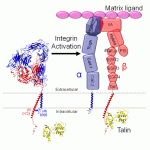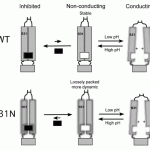NMR
Last year, I wrote about a scientific controversy over the structure of the influenza M2 proton channel, particularly over the protein's binding site for adamantane type anti-flu drugs. The Schnell/Chou model, based on solution NMR, had the drug binding to the outside of the channel, within the membrane (at a 4:1 drug:protein ratio). On the other hand, the Stouffer/DeGrado model had the drug binding inside the channel (1:1 ratio), based on X-ray crystallography studies.
A new study was recently published in Nature (the same journal that published the original two competing papers), based this…
Just as I was in the process of finishing my doctorate in August, I found out that my first first-author paper had been accepted for publication by The EMBO Journal. This was good news, because we were reporting some pretty fundamental findings in a relatively saturated field, and one of our competitors had managed to successfully stall the acceptance of this paper since March. Up until that point, witnessing this happen firsthand had been a somewhat frustrating and disillusioning experience for a young scientist, but I think that we were vindicated in the end. Anyway, this paper--and another…
On Wednesday, the CDC reported that influenza A H1N1 viruses from 13 patients with confirmed diagnoses of swine flu had been tested for resistance to a variety of antiviral drugs. The good news was that all of the isolates were susceptible to the antiviral drugs oseltamivir (Tamiflu) and zanamivir (Relenza). However, all 13 were resistant to adamantane-based drugs (amantadine and rimantadine). Resistance to adamantane drugs (which were developed first) has actually become quite widespread among flu viruses in general, so oseltamivir and zanamivir are commonly the drugs of choice.
The…
Cells in higher organisms exist in a dynamic environment, requiring the ability to alternately grasp and disengage from the three-dimensional web of their surroundings. One family of proteins in particular, the integrins, plays a key role in this process by acting as the hands of the cell. Spanning the cell membrane, they link the extracellular matrix to the cell's internal cytoskeleton. Integrins are especially interesting, though, because the cell uses them to uniquely pass signals in both directions across the membrane, and an integrin's adhesiveness for the extracellular matrix can be…
Molecule of the Day has a post up about isotopically-enriched food that caught my eye for a couple of reasons. Firstly, the idea is wildly outrageous, and, secondly, this is something that actually gets joked about quite a bit in an NMR (nuclear magnetic resonance) lab.
Any given element can come in various isotopes, which differ in the composition of their nuclei. The nuclei of different isotopes of the same element have the same number of protons, but they vary in their number of neutrons. Because the number of neutrons in a nucleus does not significantly affect the chemical properties…
There really aren't that many blogs out their written by scientists about the science that they do, and this seems particularly true in my area of study, NMR (nuclear magnetic resonance). I have been able to find a few, although none of them focus specifically on biological or macromolecular NMR. The following list is, of course, not meant to be comprehensive, and if anyone knows of any other NMR blogs, I would love to hear about them.
Stan's NMR Blog: This blog, run by Italian physicist Stanislav Sykora, seems to be the most comprehensive and regularly updated of the NMR blogs I've come…
One of the goals of modern structural biology is to integrate the two traditionally distinct subfields of structural molecular biology (determination of the structures of macromolecules at atomic resolution) and structural cell biology (general architecture of of the cell and the localization of subcellular structures within it). The end result--as my research advisor at Oxford, Prof. Iain Campbell, often points out--is to be able to make a "molecular movie", at atomic resolution, of the whole cell. (Such a video might look something like this video from XVIVO and Harvard University--…
On the weekend of July 28th-30th, about 150 NMR (nuclear magnetic resonance) scientists from the UK and Europe (and a few from the US) gathered in Ambleside for the Sixth Annual Collaborative Computing Project for NMR (CCPN) Meeting. The topic of the meeting was "Efficient and Rapid Structure Determination by NMR", and it included presentations by twelve NMR scientists, a demonstration of the CCPN software, and about thirty research posters on various NMR talks.
Note: for more background on NMR, check out my previous post on the topic.
Biomolecular NMR is a rapidly growing field, one that…
As you may have seen, the web is all abuzz today with news and commentary on the 150th birthday of the scientists and inventor Nikola Tesla. Tesla is probably best known as the inventor of the modern radio, but he had his hands in almost every area of electronics and magnetism research in his day. Because of his many inventions in the area, he is often called "the man who invented the Twentieth Century", a title that is surely well-deserved. His presence has seemed to only grow stronger with time, and even today his memory is allowing Serbia and Croatia to look past their uneasy past and…
There are a number of approaches scientists take to get at the fundamental nature of life, and one of those is elucidating the chemical structures of the molecules that make life happen, particularly proteins, which are the workhorses of the cell. One of the two primary methods for determining these structures is nuclear magnetic resonance (NMR) and the other is x-ray crystallography. My current work is in the former, meaning I spend a lot of time sitting in front of a huge magnet and even more time staring at a computer screen trying to make sense of the data I get from the magnet. As…

